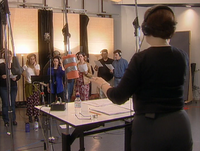Halo Theme: Difference between revisions
From Halopedia, the Halo wiki
mNo edit summary |
No edit summary |
||
| Line 20: | Line 20: | ||
[[File:Chanting_monks.png|left|thumb|The song being recorded.]] | [[File:Chanting_monks.png|left|thumb|The song being recorded.]] | ||
The theme was again revised for ''[[Halo 3]]'', this time recorded with a live orchestra instead of synthesized strings. The version used in ''Halo 3'' finishes with the ending used at the end of ''[[The Maw ( | The theme was again revised for ''[[Halo 3]]'', this time recorded with a live orchestra instead of synthesized strings. The version used in ''Halo 3'' finishes with the ending used at the end of ''[[The Maw (level)|The Maw]]'', as opposed to the reprise of the opening chant used in the original theme and the MJOLNIR Mix. | ||
The soundtrack for ''[[Halo Wars]]'', composed by [[Stephen Rippy]], also uses the ''Halo Theme'' at various points, most prominently during ''[[Spirit of Fire (music)|Spirit of Fire]]''. | The soundtrack for ''[[Halo Wars]]'', composed by [[Stephen Rippy]], also uses the ''Halo Theme'' at various points, most prominently during ''[[Spirit of Fire (music)|Spirit of Fire]]''. | ||
Revision as of 19:54, December 9, 2011
The Halo Theme is the staple music of the Halo series.
Use
In its original incarnation, featured frequently in Halo: Combat Evolved, it placed heavy emphasis on deep, powerful drums and fast paced strings. The song is heard most prominently at the start of Silent Cartographer, during the beach landing and during the final Warthog run segment of The Maw. The chant at the beginning of the piece was used for the main menu screen in-game. 343 Guilty Spark will hum it in Halo 3 with the IWHBYD skull on. It is the first true music heard by the player. On the Halo: Original Soundtrack, however, it was the last track, and also included the bonus track Siege of Madrigal at the end.
For Halo 2, the song was remixed into the MJOLNIR Mix. The basics of the song remain the same, but it features electric guitar overlays by former Whitesnake guitarist Steve Vai. Halo 2 uses the song in its original form in certain parts, such as at the beginning of the level Metropolis. The MJOLNIR mix is played at the end of Metropolis as the Master Chief boards the Scarab, and later during the end credits. It is the first track on the Halo 2 Soundtrack Volume 1.
The theme was again revised for Halo 3, this time recorded with a live orchestra instead of synthesized strings. The version used in Halo 3 finishes with the ending used at the end of The Maw, as opposed to the reprise of the opening chant used in the original theme and the MJOLNIR Mix.
The soundtrack for Halo Wars, composed by Stephen Rippy, also uses the Halo Theme at various points, most prominently during Spirit of Fire.
A partial remix of the track appears in the Halo Legends Original Soundtrack. This remix plays during Halo Legends episode Origins during the scenes depicting the escalation of the Human-Covenant War.
The Halo Theme does not appear in Halo 3: ODST. While stated before release that the Theme would not appear in Halo: Reach,[1] an orchestral re-imagining is used in the opening segment of the track Tip of the Spear, while certain motifs are also present in several other tracks, such as Overture.
A re-orchestrated version of the song serves as the theme of Halo: Combat Evolved Anniversary.
The Halo Theme is used in the closing moments of the teaser trailer for Halo 4, implying that the Theme will appear in the game itself.
Trivia
- It was composed over the course of three days in the summer of 1999 by Martin O'Donnell.[citation needed]
- The country of Palestine aired government-sponsored music videos, and plays, one of which, according to a source, used the Halo Theme music without Bungie's sanction.[2]
- The opening Gregorian chant consists of a series of 28 (seven times four) notes. Additionally, the second and fourth 'phrases' of the chant each consist of seven notes.
Sources
- ^ EDGE Magazine, February 2010
- ^ Halo.bungie.org: Halo music used in political video.
